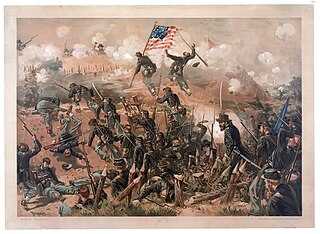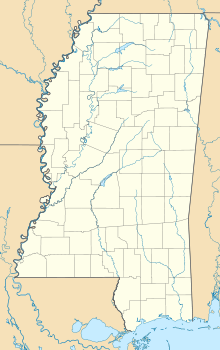| Siege of Vicksburg | |||||||
|---|---|---|---|---|---|---|---|
| Part of the Vicksburg campaign of the Western Theater of the American Civil War | |||||||
 The Siege of Vicksburg - Assault on Fort Hill by Thure de Thulstrup | |||||||
| |||||||
| Belligerents | |||||||
|
|
| ||||||
| Commanders and leaders | |||||||
|
|
| ||||||
| Units involved | |||||||
| Army of the Tennessee | Army of Mississippi | ||||||
| Strength | |||||||
| ~77,000[2] | ~33,000 | ||||||
| Casualties and losses | |||||||
| 4,835 total |
32,697 total (3,202 killed/wounded/missing 29,495 surrendered)[3] 172 cannons captured by United States | ||||||
Location within the Confederate State of Mississippi | |||||||
The siege of Vicksburg (May 18 – July 4, 1863) was the final major military action in the Vicksburg campaign of the American Civil War. In a series of maneuvers, Union Maj. Gen. Ulysses S. Grant and his Army of the Tennessee crossed the Mississippi River and drove the Confederate Army of Mississippi, led by Lt. Gen. John C. Pemberton, into the defensive lines surrounding the fortress city of Vicksburg, Mississippi.
Vicksburg was the last major Confederate stronghold on the Mississippi River; therefore, capturing it completed the second part of the Northern strategy, the Anaconda Plan. When two major assaults against the Confederate fortifications, on May 19 and 22, were repulsed with heavy casualties, Grant decided to besiege the city beginning on May 25. After holding out for more than forty days, with their supplies nearly gone, the garrison surrendered on July 4. The successful ending of the Vicksburg campaign significantly degraded the ability of the Confederacy to maintain its war effort. This action, combined with the surrender of the down-river Port Hudson to Maj. Gen. Nathaniel P. Banks on July 9, yielded command of the Mississippi River to the Union forces, who would hold it for the rest of the conflict.
The Confederate surrender on July 4, 1863, is sometimes considered, when combined with Gen. Robert E. Lee's defeat at Gettysburg by Maj. Gen. George Meade the previous day, the turning point of the war. It cut off the Trans-Mississippi Department (containing the states of Arkansas, Texas and part of Louisiana) from the rest of the Confederate States, effectively splitting the Confederacy in two for the rest of the war. Lincoln called Vicksburg "the key to the war."[4]
- ^ National Park Service. Grant's army arrived at the outskirts of Vicksburg on May 19, but formal siege operations began with Grant's Special Order No. 140 on May 25 (Simon, p. 267).
- ^ Kennedy, p. 172.
- ^ a b Cite error: The named reference
K173was invoked but never defined (see the help page). - ^ Vicksburg, Mailing Address: 3201 Clay Street; Us, MS 39183 Phone:636-0583 Contact. "History & Culture - Vicksburg National Military Park (U.S. National Park Service)". www.nps.gov. Retrieved January 14, 2021.
{{cite web}}: CS1 maint: numeric names: authors list (link)


